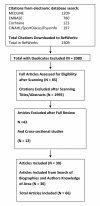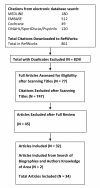Physical activity and functional limitations in older adults: a systematic review related to Canada's Physical Activity Guidelines
- PMID: 20459782
- PMCID: PMC2882898
- DOI: 10.1186/1479-5868-7-38
Physical activity and functional limitations in older adults: a systematic review related to Canada's Physical Activity Guidelines
Abstract
Background: The purpose was to conduct systematic reviews of the relationship between physical activity of healthy community-dwelling older (>65 years) adults and outcomes of functional limitations, disability, or loss of independence.
Methods: Prospective cohort studies with an outcome related to functional independence or to cognitive function were searched, as well as exercise training interventions that reported a functional outcome. Electronic database search strategies were used to identify citations which were screened (title and abstract) for inclusion. Included articles were reviewed to complete standardized data extraction tables, and assess study quality. An established system of assessing the level and grade of evidence for recommendations was employed.
Results: Sixty-six studies met inclusion criteria for the relationship between physical activity and functional independence, and 34 were included with a cognitive function outcome. Greater physical activity of an aerobic nature (categorized by a variety of methods) was associated with higher functional status (expressed by a host of outcome measures) in older age. For functional independence, moderate (and high) levels of physical activity appeared effective in conferring a reduced risk (odds ratio ~0.5) of functional limitations or disability. Limitation in higher level performance outcomes was reduced (odds ratio ~0.5) with vigorous (or high) activity with an apparent dose-response of moderate through to high activity. Exercise training interventions (including aerobic and resistance) of older adults showed improvement in physiological and functional measures, and suggestion of longer-term reduction in incidence of mobility disability. A relatively high level of physical activity was related to better cognitive function and reduced risk of developing dementia; however, there were mixed results of the effects of exercise interventions on cognitive function indices.
Conclusions: There is a consistency of findings across studies and a range of outcome measures related to functional independence; regular aerobic activity and short-term exercise programmes confer a reduced risk of functional limitations and disability in older age. Although a precise characterization of a minimal or effective physical activity dose to maintain functional independence is difficult, it appears moderate to higher levels of activity are effective and there may be a threshold of at least moderate activity for significant outcomes.
Figures




Similar articles
-
Behavioural modification interventions for medically unexplained symptoms in primary care: systematic reviews and economic evaluation.Health Technol Assess. 2020 Sep;24(46):1-490. doi: 10.3310/hta24460. Health Technol Assess. 2020. PMID: 32975190 Free PMC article.
-
Prevention of falls and fall-related injuries in community-dwelling seniors: an evidence-based analysis.Ont Health Technol Assess Ser. 2008;8(2):1-78. Epub 2008 Oct 1. Ont Health Technol Assess Ser. 2008. PMID: 23074507 Free PMC article.
-
The future of Cochrane Neonatal.Early Hum Dev. 2020 Nov;150:105191. doi: 10.1016/j.earlhumdev.2020.105191. Epub 2020 Sep 12. Early Hum Dev. 2020. PMID: 33036834
-
Promoting and supporting self-management for adults living in the community with physical chronic illness: A systematic review of the effectiveness and meaningfulness of the patient-practitioner encounter.JBI Libr Syst Rev. 2009;7(13):492-582. doi: 10.11124/01938924-200907130-00001. JBI Libr Syst Rev. 2009. PMID: 27819974
-
Effectiveness of exercise interventions on physical function in community-dwelling frail older people: an umbrella review of systematic reviews.JBI Database System Rev Implement Rep. 2018 Mar;16(3):752-775. doi: 10.11124/JBISRIR-2017-003551. JBI Database System Rev Implement Rep. 2018. PMID: 29521871
Cited by
-
Sedentary behavior and physical activity are independent predictors of successful aging in middle-aged and older adults.J Aging Res. 2012;2012:190654. doi: 10.1155/2012/190654. Epub 2012 Sep 11. J Aging Res. 2012. PMID: 22997579 Free PMC article.
-
Normative Data of Objectively Measured Physical Activity and Sedentary Time in Community-Dwelling Older Japanese.Int J Environ Res Public Health. 2021 Mar 30;18(7):3577. doi: 10.3390/ijerph18073577. Int J Environ Res Public Health. 2021. PMID: 33808283 Free PMC article.
-
Physical Activity, Central Adiposity, and Functional Limitations in Community-Dwelling Older Adults.J Geriatr Phys Ther. 2016 Apr-Jun;39(2):71-6. doi: 10.1519/JPT.0000000000000051. J Geriatr Phys Ther. 2016. PMID: 25794309 Free PMC article.
-
Advancing the future of physical activity guidelines in Canada: an independent expert panel interpretation of the evidence.Int J Behav Nutr Phys Act. 2010 May 11;7:41. doi: 10.1186/1479-5868-7-41. Int J Behav Nutr Phys Act. 2010. PMID: 20459785 Free PMC article.
-
Risk Profiles for Care Dependency: Cross-Sectional Findings of a Population-Based Cohort Study in Germany.J Aging Health. 2020 Jun/Jul;32(5-6):352-360. doi: 10.1177/0898264318822364. Epub 2019 Jan 18. J Aging Health. 2020. PMID: 30658538 Free PMC article.
References
-
- Paterson D, Jones G, Rice C. Ageing and physical activity: evidence to develop exercise recommendations for older adults. Can J Public Health. 2007;98:S69–S108. - PubMed
LinkOut - more resources
Full Text Sources
Medical
Miscellaneous

